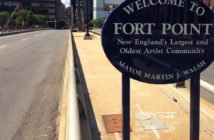In early 2015, the City of Boston began its first cultural plan; an approximately fifteen month process that begins with developing a comprehensive view of Boston’s arts and culture sector, and ends with implementing a custom-made plan to strengthen and grow Boston’s cultural ecosystem. The cultural plan has been named Boston Creates; it will be led by the Cultural Planning Group, a contracted consulting firm, and will be overseen by Julie Burros, Chief of the newly formed Arts + Culture Department for the City of Boston.
On June 2, a public town hall meeting was held at English High School to officially begin the cultural planning process. Brief presentations were given by Julie Burros of the Arts + Culture Department, and David Plettner-Saunders of the Cultural Planning Group, outlining the goals of the cultural planning process. These presentations were followed by breakout sessions, where attendants formed groups of 10 to 40, sharing their expectations of the plan as well as their hopes for the future of Boston’s creative economy. Arts professionals and community leaders served as facilitators for these breakout groups.
Ron Mallis, who participated as a facilitator, reflects on his experience that evening.
Somewhere around 450 people packed the English High School auditorium the evening of June 2, participating in the public launch of Boston Creates—described as a broad citywide effort to generate, as the initiative’s website states, a "shared vision for arts and culture" and, from that vision, a resulting "cultural blueprint."
Somewhere around 450 people: that was possibly the most significant take-away from the event. That, and the crowd’s diversity: many ages, ethnic backgrounds, and neighborhoods were represented. Citizens with direct and indirect relationships to arts and culture (whether as consumers or providers) were also present. None of the rhetorical flourishes or PowerPoint slides, could—or should—compete with what this level of interest and attendance implicitly stated: We’re here, and this stuff, this arts and culture, this is important to us and for us, maybe even in ways that aren’t easy to articulate. Allow us to make something happen. And give credence to what we do.
A strong desire to get to it, to identify specific actions and priorities, shaped the discussion within the breakout group I facilitated. This group included: several artists, a senior staffer from a local foundation, an accountant, a banker, a curator, and the head of a local arts organization. If there was an overriding theme or goal within this group, it had to do with acting on—not just talking about—the imperative of ensuring that arts and culture receive explicit and equal billing with all organizations that comprise the City’s ecosystem, from local community organizations to city agencies.
Members of the group repeatedly called for cross-sector coordination, focusing, for example, on what might result from closer links between Boston’s Main Streets districts, the numerous Open Studio initiatives throughout the City, and even New England Open Markets. Words like "coordination" and "new connections" were repeated many times, both as a practice and as a result. Similarly, members of the group expressed a desire to see the development and implementation of new policies that will reflect and support Boston’s cultural ecosystem.
The speechifying that preceded these small-group sessions that Tuesday evening was perhaps by necessity a bit generic: the process is, after all, just getting underway. Nevertheless, when thinking again about the remarkable show of interest in this initiative, I realized that the highest priority for Boston Creates should be to show, as effectively and as rapidly as possible, proof of concept: specifically, as the process moves forward, it should generate a series of intermediate actions. These high impact actions could be small scale, but need to bring along the hundreds of people who were present at the initial Town Hall, and ultimately vastly expand that total.
If there are to be—and there should be—follow-up Town Hall sessions, they must not only drill down into the details, but must also elicit participation from throughout City government. If this notion of strengthening the cultural ecosystem is to have any validity, future Town Halls must also include explicit and committed participation by those engaged in other citywide planning efforts, including most especially Boston 2030 (the Mayor's initiative for developing a citywide plan for Boston, knitting together projects already underway in the areas of housing, transportation, health, climate action and arts and culture, just to name a few.)
Boston Creates is considerably more than a series of press releases. Boston Creates should be a continuing dialogue with identifiable outcomes, based on the questions: "What are we doing now?" and, "What are we going to do tomorrow?" It should also be enormously self-conscious in defining that first-person-plural pronoun: we. We, as a community of engaged citizens, go beyond City Hall, beyond any individual organization, beyond even the hundreds gathered at English High School on June 2. No one said it would be easy. But a lot of folks said it would be essential. And I for one agree with them.




